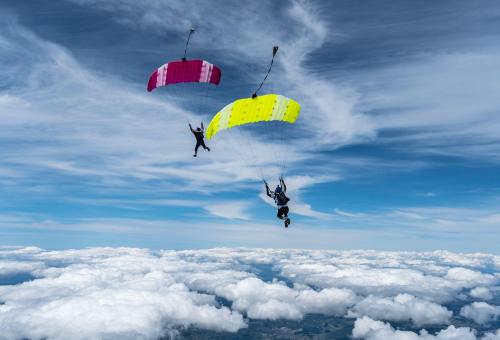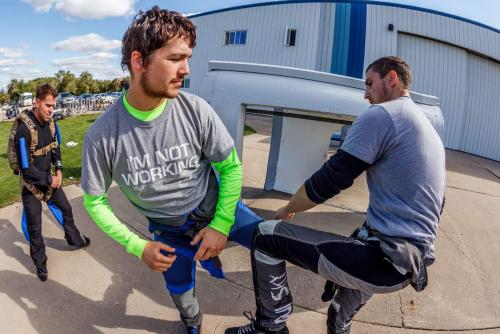Introducing the JFX 2 from NZ Aerosports
“SAME SAME, BUT BETTER-ER”. The JFX 2. She's kinda familiar, but she has that shiny new kid appeal with her modern flair and style. Powerband, mini-ribs, all the bells and whistles. Take her for a ride, baby!
We’ve done it again! We released the new version of our beloved JFX canopy, the JFX 2, on the 17th of January 2019. The original JFX was already a great canopy to fly with beautiful openings, great flight and the opportunity to land it gently or with a full-blown hissing swoop. Version 2.0 has not been a radical redesign: the JFX 2 stays true to all the things a canopy pilot loves, but now has all the kickass features they know and want in a modern cross-braced canopy: a powerband, mini-ribs and sail loaded ribs. This canopy is all about cross-braced performance with ease: cranking turns, raging swoops, gentle touchdowns!
The JFX 2 is the go-to canopy for someone wanting to start their swoop journey, or for someone who wants a “do-it-all” wing with power which will maximise the good times and minimise the risk with plenty of playfulness. This canopy is the smoothest transition into flying high performance, cross-braced wings from an elliptical wing. It can be loaded light of heavy for consistent delivery in flight.
JFX 2 | Icarus Canopies NZ from NZ Aerosports Ltd on Vimeo.
The original JFX was the last of our canopies to be designed purely by Paul “Jyro” Martyn’s keen eye and 35+ years of experience. With the JFX 2 we’ve added a touch of fancy French Aerodynamic genius to the mix from our head designer Julien Peelman, and the result means incredible aerodynamics, refined performance and uncompromised aesthetics. Key features of the JFX 2:
Powerband: debuted on the “Petra”, the Powerband lets us control the shape of the top surface of the wing more accurately, especially at the crucial leading edge where around 90% of lift is made
Mini-ribs: These little additions in the tail are also a legacy from the “Petra” and “Leia” canopies. They decrease trailing edge drag, which has the function of increasing glide and flare performance - both things you can never get enough of
“Minybrid” construction: A low-pack-volume take on our hybrid construction “Leia” canopies, the JFX 2 pioneers the minimal hybrid (Minybrid) wing. The loaded ribs - the ones the lines are attached to that experience the highest amount of stress and distortion - are made of sail fabric. This reduces rib distortion, helping the wing maintain its shape through all flight profiles, increasing glide, stability and responsiveness
21-chamber design: The JFX 2's sleek fully elliptical 21-chamber design captures the smoothed staged openings of the traditional 7-cell. She's crisp and responsive, yet it does not feel tense and edgy and packs some punch at the bottom end
Closed Center Chamber: Inherited originally from the “FX” and “VX”, then redesigned for the “JVX”, the closed center chamber nose was the innovation that allowed cross-braced canopies to become popular by softening the openings, controlling distortion and improving aerodynamics. It's not the latest but probably one of the most important of Jyro's contributions to modern canopy design!
Images by Chris Stewart/NZ Aerosports
Key flight characteristics:
Openings: JFX 2 openings are predictable, soft and not scary! Reliable, consistent and stunning as always, openings are the ace card of this canopy
Harness inputs: inputs are light and instinctive, and very responsive. She can be flown entirely on harness with ease - we actually prefer to fly a lot of harness with the JFX 2
Toggles: Powerful and responsive even at the bottom end - even more so than the original JFX
Stall point: The slow flight characteristics are hugely improved from the original JFX. The stall point is slower and lower - get plenty of feedback and warning, both on toggles and rears
Fronts: Loaded high, lightly and even underloaded; the feedback of the fronts will be great. A bit of slowing down needed before a bigger turn to reduce the pressure on the fronts, but they are very effective for getting into the dive
Dive & Recovery: The dive on the JFX 2 is longer than the original JFX, but not as long as on the Leia. With a slow, predictable (and easily adjustable) recovery arc, the JFX 2 is ideal to get those bigger rotations dialled in.



